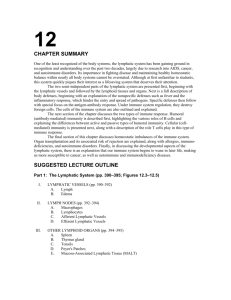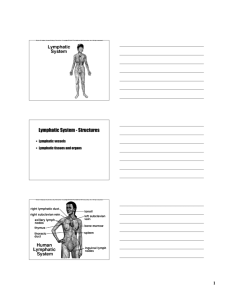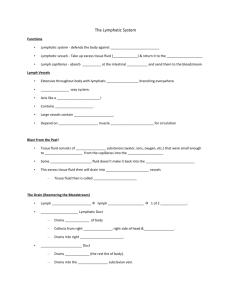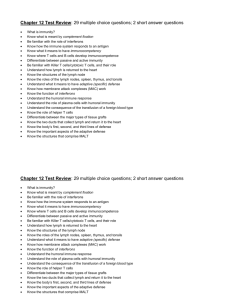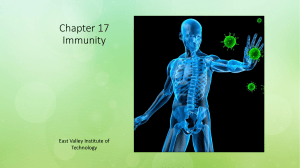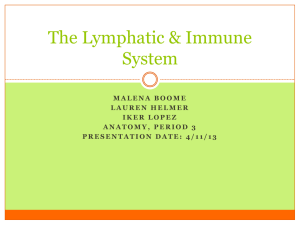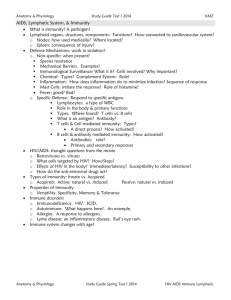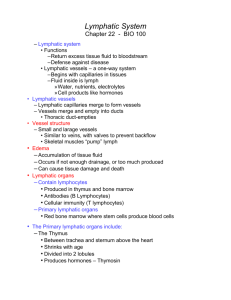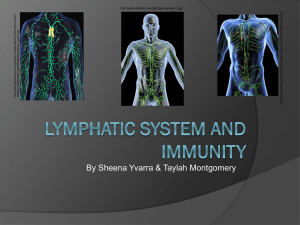Capillary exchange Fluid movement in capillaries Lymphatic system
advertisement
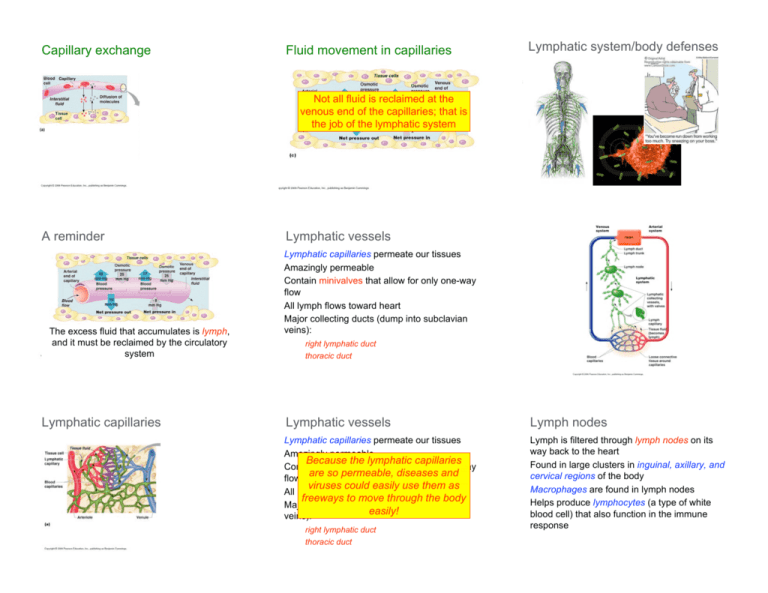
Capillary exchange Fluid movement in capillaries Lymphatic system/body defenses Not all fluid is reclaimed at the venous end of the capillaries; that is the job of the lymphatic system A reminder The excess fluid that accumulates is lymph, and it must be reclaimed by the circulatory system Lymphatic capillaries Lymphatic vessels Lymphatic capillaries permeate our tissues Amazingly permeable Contain minivalves that allow for only one-way flow All lymph flows toward heart Major collecting ducts (dump into subclavian veins): right lymphatic duct thoracic duct Lymphatic vessels Lymph nodes Lymphatic capillaries permeate our tissues Amazingly permeable Because the lymphatic capillaries Contain minivalves that allow for only one-way are so permeable, diseases and flow viruses could easily use them as All lymph flows toward heart freeways to move through the body Major collecting ducts (dump into subclavian easily! veins): Lymph is filtered through lymph nodes on its way back to the heart Found in large clusters in inguinal, axillary, and cervical regions of the body Macrophages are found in lymph nodes Helps produce lymphocytes (a type of white blood cell) that also function in the immune response right lymphatic duct thoracic duct Distribution of lymph nodes Nonspecific body defenses Nonspecific body defenses = mechanical barriers that cover body surfaces/chemicals that initially act to protect the body from invading pathogens Surface membrane barriers Acid pH of skin secretions inhibits bacterial growth Stomach secretes HCl and proteinases Saliva and lacrimal fluid contains lysozyme Mucus traps bacteria that would enter respiratory tract Cells and chemicals Phagocytes (macrophages and neutrophils) engulf foreign particles Natural killer cells can recognize foreign pathogens, and inject a lytic enzyme into the cell, causing it to disintegrate Phagocytosis Nonspecific body defenses Antimicrobial chemicals Complement: at least 20 plasma proteins that are inactivated until attached to foreign cells; can cause foreign cells to burst (membrane attack complexes), can release chemotaxic chemicals for WBCs, or can assist macrophages Interferon: secreted by virus-infected cells to help protect neighboring cells from infection (“interferes” with viral infection) Nonspecific body defenses Fever White blood cells secrete pyrogens, which act on the hypothalamus to raise body temperature; causes liver to “take away” chemicals bacteria need and it increases metabolic rate, which speeds healing Immune response Very specific body defenses Antigen specific Systemic Has memory--is able to prime itself for later attacks by the same antigen Humoral immunity: provided by antibodies circulating in body fluids Cellular immunity: lymphocytes themselves defend the body against antigens What is an antigen? Any substance capable of exciting a response from our immune system (what we recognize as “nonself”) Pollen grains, bacteria illicit an immune response because they have foreign proteins Our cells often contain self-antigens, which our body recognizes, but other bodies may not Haptens Lymphocytes Macrophages = incomplete antigens Small molecules are not antigenic, but can link with our own proteins Allergies result All blood cells originate from stem cells in the bone marrow T cells become immunocompetent in the thymus B cells become immunocompetent in the bone marrow Once immunocompetent, a lymphocyte can bind with only one antigen--our genes determine what lymphocytes we make Acts non-specifically to engulf pathogens Acts specifically by presenting antigens to T cells T cells then release chemicals that convert the macrophages to killer macrophages Localized to lymphoid organs (T cells mature in lymph tissue, but can go all over the body) Humoral immunity Antibodies = antibody-mediated immunity = immunoglobulins Capable of binding with a specific antigen Inactivates antigens in a number of ways Humoral immunity = antibody-mediated immunity Active humoral immunity Can be naturally acquired Can be artificially acquired via vaccines Vaccines “prime” the immune system (like jumping ahead to the secondary response) We are spared the discomfort of the disease itself Sometimes booster shots are necessary to re-intensify the immune system Passive humoral immunity Antibodies are obtained from another human or animal “Borrowed” antibodies naturally degrade in the body with time Conferred naturally mother--fetal exchange Conferred artificially when one receives injections Gamma globulin (hepatitis exposure) Snake bites Tetanus Antibody structure Primary and secondary humoral responses Cell-mediated immunity Immature T cells must be presented antigens by macrophages in order to bind them Cytotoxic (killer) T cells specialize in killing virus-infected, cancer or foreign graft cells by injecting perforins under their cell membrane Helper T cells recruit B cells and cytotoxic T cells by releasing lymphokines Suppressor T cells suppress T and B cells, winding down the immune response Immunodeficiencies Severe combined immunodeficiency disease: a severe lack of B and T cells; sometimes bone marrow or umbilical cord stem cell transplants can help; victims must live in a bubble; congenital Acquired immune deficiency syndrome: interferes with the activity of helper T cells Autoimmune diseases The immune system loses its ability to recognize self-antigens ~5% of adults in North America suffer from an autoimmune disease Several very common: multiple sclerosis, type I diabetes, rheumatoid arthritis, among others

